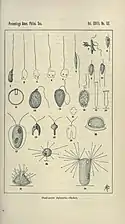| Trachelomonas cervicula | |
|---|---|
 | |
| Scientific classification | |
| Domain: | Eukaryota |
| Phylum: | Euglenozoa |
| Class: | Euglenoidea |
| Order: | Euglenales |
| Family: | Euglenaceae |
| Genus: | Trachelomonas |
| Species: | T. cervicula |
| Binomial name | |
| Trachelomonas cervicula A.Stokes | |
Trachelomonas cervicula is a species of algae from the genus Trachelomonas.[1][2] The species was first described by Alfred C. Stokes in 1890.[1][3]
Description

Trachelomonas cervicula is a species of algae that can be found in abundance in fresh water ponds. Its smooth lorica is orange and yellow in colour and almost spherical. It has an anterior orifice with a thickened, slightly projecting external border. Internally the orifice is a straight projecting external border, and produced internally as a straight, cylindrical, chitinous tube about one-third as long as the diameter of the lorica. This diameter of the lorica is 22–23 μm,[1] 18–23 μm long,[4] and 16–21 μm wide.[4] The species differs from other infusoria by the presence of the internal tubular prolongation. Its holotype was collected in some abundance from a sheltered pond in the early part of February, 1890. It is, therefore, probably a vernal species.[1]
Habitat and range
Initially the habitat of T. cervicula was described as protected pond water,[1] specimens have also been observed in rivers such as the Lematang river[5] and the Paraná River.[4] Due the scarcity of studies on the genus Trachelomonas and the large numbers of species in the genus, it is difficult to know the full range. However, observations have been recorded in South America,[4] Europe,[3][6] and Southeast Asia.[5]
Ecology
Trachelomonas cervicula has been observed in an environment highly polluted by thallium and other generally toxic heavy metal elements such as cadmium, lead and zinc.[6] Anthropogenic turbulence and pollution disturb their natural habitats, leading to a decline in natural fish stocks that depend on phytoplankton for food.[5]
References
- 1 2 3 4 5 Alfred C Stokes (1890). "Notices of New Fresh-Water Infusoria". Proceedings of the American Philosophical Society. 28 (132): 74–80. ISSN 0003-049X. JSTOR 983315. Wikidata Q106922786.
- ↑ "Trachelomonas cervicula". iNaturalist. Retrieved 2022-04-19.
- 1 2 "Trachelomonas cervicula A.Stokes". www.gbif.org. Retrieved 2022-04-19.
- 1 2 3 4 Servat, Liliane Caroline; Bueno, Norma Catarina; Alves-da-Silva, Sandra Maria (2015-02-28). "New records of Trachelomonas Ehrenberg (Euglenophyceae) in lotic environments of the buffer zone of Iguaçu National Park, Paraná, Brazil". Brazilian Journal of Botany. 38 (2): 343–356. doi:10.1007/S40415-015-0136-Z. S2CID 25895575.
- 1 2 3 Sagala, E. P. (2019-11-05). "The study of diversity index on plankton community in Lematang River to determinate the quality of waters as habitat of local fishes". IOP Conference Series: Earth and Environmental Science. 374 (1): 012019. Bibcode:2019E&ES..374a2019S. doi:10.1088/1755-1315/374/1/012019. S2CID 210280913.
- 1 2 Płachno, Bartosz J.; Wołowski, Konrad; Augustynowicz, Joanna; Łukaszek, Magdalena (2015-01-01). "Diversity of algae in a thallium and other heavy metals-polluted environment". Annales de Limnologie. 51 (2): 139–146. doi:10.1051/LIMN/2015010.